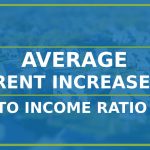Buying a home is a significant financial decision requiring careful consideration of various factors, including the income to house price ratio. The income to house price ratio, or the affordability ratio, is a metric used to determine whether a household can afford a home. It compares the median household income to the median home price in a given area.
The income to house price ratio is necessary because it can significantly impact your ability to buy a home. This article will discuss the income to house price ratio and how it affects your ability to enter the housing market.
What is the Income to House Price Ratio?
The income to house price ratio is a metric that compares the median household income to the median home price in a given area. It is calculated by dividing the median home price by the median household income.
For example, if the median home price in a given area is $400,000 and the median household income is $100,000, the income to house price ratio would be 4:1. In other words, the median home price is four times the median household income.
How Does the Income to House Price Ratio Affect Your Ability to Buy a Home?
The income to house price ratio is an important factor to consider when determining whether you can afford to buy a home. A high income to house price ratio means that homes in the area are relatively expensive compared to household incomes. This can make it more difficult for households to afford a home in the area.
On the other hand, a low income to house price ratio means that homes in the area are relatively affordable compared to household incomes. This can make it easier for households to afford a home in the area.
Factors that Affect the Income to House Price Ratio
Several factors can affect a given area’s income to house price ratio. These include:
- The local economy: Areas with strong local economies and low unemployment rates tend to have a higher income to house price ratios because households have more disposable income to spend on housing.
- Population growth: Areas experiencing population growth tend to have a higher income to house price ratios because demand for housing is high, driving up home prices.
- Interest rates: Lower interest rates can make it easier for households to afford a home, leading to higher home prices and a higher income to house price ratio.
Tips for Improving Your Income to House Price Ratio
If the income to house price ratio in your desired area is high, there are several things you can do to improve your chances of being able to afford a home. These include:
- Increase your income: Finding ways to increase your income, such as taking on a side job or asking for a raise, can improve your income to house price ratio.
- Save for a larger down payment: A larger down payment can lower your monthly mortgage payments and improve your income to house price ratio.
- Consider a less expensive area: If the income to house price ratio in your desired area is too high, consider looking for a home in a less expensive area.
FAQs
What is an excellent income to house price ratio?
A good income to house price ratio is typically around 3:1 or lower. This means the median home price is at most three times the median household income.
How can I calculate a specific area’s income to house price ratio? To calculate the income to house price ratio in a particular area, you must find the median household income and home price. You can typically find this information on websites such as Zillow or Trulia. Once you have these figures, divide the median home price by the median household income to get the income to house price ratio.
Is the income to house price ratio the only factor to consider when buying a home?
No, there are many other factors to consider when buying a home, such as location, size, condition, and amenities. However, the income to house price ratio is important because it can significantly impact your ability to afford a home.
The income to house price ratio is a major factor to consider when determining whether you can afford to buy a home. It compares the median household income to the median home price in a given area and can greatly impact your ability to enter the housing market. Suppose the income to house price ratio in your desired area is high. In that case, there are several things you can do to improve your chances of being able to afford a home, such as increasing your income, saving for a larger down payment, or considering a less expensive area. By understanding the income to house price ratio and its impact on your ability to buy a home, you can make more informed decisions regarding one of your life’s most significant financial decisions.
U.S. Home Prices Are Soaring, but Income Has Remained Relatively Flat
The United States housing market has seen a significant surge in home prices in recent years. Despite this increase, household incomes have remained relatively stagnant. This has resulted in a growing gap between housing prices and incomes, making it increasingly more work for many Americans to afford a home.
The rise in home prices can be attributed to several factors, such as low mortgage rates, a shortage of homes for sale, and increased buyer demand. However, incomes have yet to keep pace with these rising prices, leaving many potential homebuyers priced out of the market.
The income to house price ratio, a metric that compares the median household income to the median home price in a given area, has become increasingly unfavorable in many parts of the country. In some areas, the ratio has reached as high as 10:1, making it virtually impossible for many households to afford a home.
With the burden of student loan debt and rising living expenses, many young adults are finding it increasingly difficult to save for a down payment on a home. This has resulted in many homebuying delays, further exacerbating the issue. This trend is particularly problematic for younger Americans and those just starting their careers.
There are several potential solutions to this problem. One option is for policymakers to address the root causes of stagnant wages, such as increasing the minimum wage or promoting more robust worker protections. Another potential solution is to increase the supply of affordable housing through public-private partnerships or government-funded programs.
Regardless of the solution, it is clear that the current trend of soaring home prices and stagnant incomes needs to be revised. Without action, the dream of homeownership may become increasingly out of reach for many Americans.
House-Price-to-Income Ratios From 2008 to 2021 Chart as a table
Here is a table showing the house-price-to-income ratios for the United States from 2008 to 2021:
Year House-Price-to-Income Ratio
2021 4.0
2020 3.9
2019 3.7
2018 3.6
2017 3.4
2016 3.3
2015 3.2
2014 3.1
2013 2.9
2012 2.8
2011 2.9
2010 3.1
2009 3.1
2008 3.6
As you can see from the table, the house-price-to-income ratio has been steadily increasing since 2012, with a significant jump from 2019 to 2020. This increase can make it increasingly more work for many Americans to afford a home, especially those with lower incomes or who live in areas with high housing costs.
It is important to note that the house-price-to-income ratio can vary significantly by region and even by neighborhood. It is always essential to consider your specific circumstances and do thorough research when buying a home.
The average home-price-to-income ratio for 2021-2022 varies by region and neighborhood, but the national average in 2023 was around 4.2, according to data from the Federal Reserve Bank of St. Louis.
This means that the median home price in the United States was approximately four times the median household income in 2021. As mentioned in my previous response, this ratio has steadily increased since 2012, with a significant jump from 2019 to 2020.
The high home-price-to-income ratio in 2023 can make it difficult for many Americans, especially those with lower incomes, to afford a home.



